
Charleston is the largest city in the U.S. state of South Carolina, the county seat of Charleston County, and the principal city in the Charleston–North Charleston metropolitan area. The city lies just south of the geographical midpoint of South Carolina's coastline on Charleston Harbor, an inlet of the Atlantic Ocean formed by the confluence of the Ashley, Cooper, and Wando rivers. Charleston had a population of 150,277 as of the 2020 U.S. Census. The 2020 population of the Charleston metropolitan area, comprising Berkeley, Charleston, and Dorchester counties, was 799,636 residents, the third-largest in the state and the 74th-largest metropolitan statistical area in the United States.
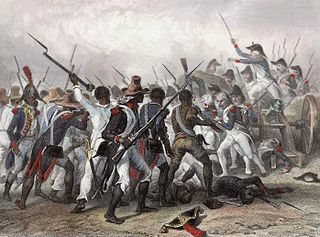
Denmark Vesey was a Black American leader in Charleston, South Carolina. He worked as a carpenter. In June 1822 he was accused and convicted of being the leader of "the rising," a potentially major slave revolt which was scheduled to take place in the city on July 14. He was executed on July 2.

James Hamilton Jr. was an American lawyer and politician. He represented South Carolina in the U.S. Congress (1822–1829) and served as its 53rd Governor (1830–1832). Prior to that he achieved widespread recognition and public approval for his actions as Intendant (mayor) of the city of Charleston, South Carolina in 1822, during the period when plans for a slave rising were revealed. As governor, he led the state during the Nullification Crisis of 1832, at the peak of his power.

The Citadel, The Military College of South Carolina, commonly known simply as The Citadel, is a public senior military college in Charleston, South Carolina. Established in 1842, it is one of six senior military colleges in the United States. It has 18 academic departments divided into five schools offering 23 majors and 38 minors. The military program is made up of cadets pursuing bachelor's degrees who live on campus. The non-military programs offer 12 undergraduate degrees, 26 graduate degrees, as well as evening and online programs with seven online graduate degrees, three online undergraduate degrees, and three certificate programs.

Thomas Bennett Jr. was an American businessman, banker and politician, the 48th Governor of South Carolina from 1820 to 1822. A respected politician, he had served several terms in the state legislature since 1804, including four years as Speaker of the House, and a term in the state Senate.

The South Carolina Governor's Mansion is a historic U.S. governor's mansion in the Arsenal Hill neighborhood of Columbia, South Carolina and the official residence of the Governor of South Carolina. It is a Federal style home influenced by British Colonial plantations. The building has a white stucco exterior and originally served as faculty quarters for the Arsenal Academy, which together with the Citadel Academy in Charleston formed the South Carolina Military Academy. The Arsenal was burned along with the city of Columbia by Sherman's forces in February, 1865; the structure was the only surviving building and became South Carolina's executive mansion in 1868. On June 5, 1970, the building was registered with the U.S. National Register of Historic Places. The mansion is located on a single city block, and is surrounded by magnolia plants, elm and oak trees, and various other plants. It is accessed by a circular driveway around a fountain in front on the residence's main entrance. The building has a flat roof and a large central pavilion around the main entrance. The mansion has 15 rooms. It is located in Columbia Historic District I. The mansion is currently occupied by Governor Henry McMaster and his family.

Commonly known as the Denmark Vesey House, the house located at 56 Bull Street in Charleston, South Carolina is almost certainly not the house once inhabited by black abolitionist Denmark Vesey. Vesey's rented home, owned first by attorney George Cross and later by white carpenter Benjamin Ireland, listed as 20 Bull Street under the city's former numbering system, is now evidently gone. A nearby home, most likely built in the 1830s or 1840s and currently numbered 56 Bull Street, was thought in the 1970s to have been the home of Denmark Vesey, and it was designated as a National Historic Landmark in 1976 by the Department of Interior.
The South Carolina Military Academy was a predecessor, two-campus institution to The Citadel. It was established in 1842 by the South Carolina Legislature.
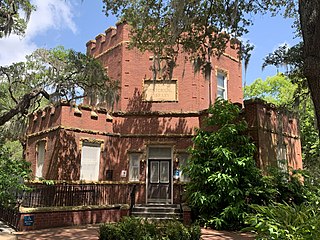
The Charleston Arsenal was a United States Army arsenal facility in Charleston, South Carolina, seized by state militia at the outbreak of the American Civil War.
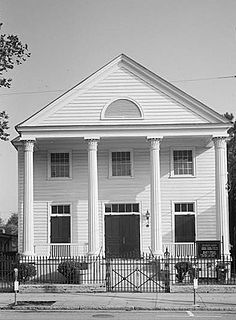
Old Bethel United Methodist Church is located at 222 Calhoun Street, Charleston, South Carolina. It is the oldest Methodist church still standing in the city.
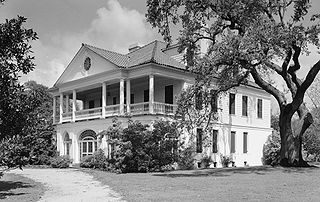
Lowndes Grove, also known as The Grove or Grove Farm, is a waterfront estate built in about 1786 on the Ashley River in Charleston. It is located in the Wagener Terrace neighborhood on a triangular plot of land bordered by St. Margaret Street, 5th Avenue, and 6th Avenue. It was named to the National Register of Historic Places on August 30, 1978.

The history of Charleston, South Carolina, is one of the longest and most diverse of any community in the United States, spanning hundreds of years of physical settlement beginning in 1670 through modern times. Charleston was the leading city in the South from the colonial era to the Civil War The city grew wealthy through the export of rice and, later, sea island cotton and it was the base for many wealthy merchants and landowners.
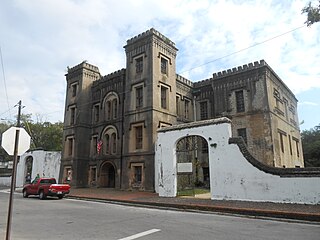
The Old Charleston Jail is a site of historical and architectural significance in Charleston, South Carolina. Operational between 1802 and 1939, it held many notable figures, among them Denmark Vesey, Union officers during the Civil War, high-seas pirates, and Lavinia Fisher. While it has become a popular tourist destination in recent years, it remains one of the most notable historic sites in Charleston that has not been the target of a comprehensive preservation and/or renovation effort. It is also commonly referred to as the Old City Jail by the people of Charleston, South Carolina.

American College of the Building Arts (ACBA) is a private four-year liberal arts and sciences college located in Charleston, South Carolina. It is licensed by the South Carolina Commission on Higher Education to grant a Bachelor of Applied Science and an Associate of Applied Science in six craft specializations in the building arts.
The President of The Citadel is the chief administrator of The Citadel. Previously known as the Superintendent, the title was changed in 1921 during the tenure of Colonel Oliver J. Bond.

The Emanuel African Methodist Episcopal Church, often referred to as Mother Emanuel, is a church in Charleston, South Carolina. Founded in 1817, Emanuel AME is the oldest African Methodist Episcopal church in the Southern United States. This, the first independent black denomination in the United States, was founded in 1816 in Philadelphia, Pennsylvania.
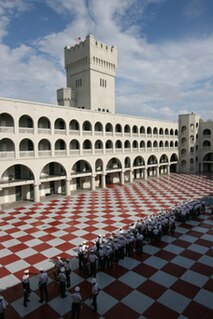
The History of The Citadel began in the early 1820s with the formation of a militia and state arsenal in response to an alleged slave revolt in 1822. By 1842 the arsenal grew into an academy, with the Legislature establishing it as the South Carolina Military Academy. Cadets played a key role in the Civil War, by firing upon a federal ship three months before the war began. Many Confederate officers attended the school. Renamed in 1910 as The Citadel, the school's academic reputation grew. After moving the campus near Hampton Park in 1922, the college has grown substantially. Sixteen years after legal segregation ended in public schools, the Citadel saw the graduation of its first Black student, Charles D. Foster. After an equally rocky journey forward, the Citadel graduated its first female Cadet in 1999. The school has produced many military officers, business, and political leaders throughout its history.

The Arsenal Academy was a military academy in Columbia, South Carolina, originally established in 1842 as an independent school by the state of South Carolina. In 1845, the academy became a component of the South Carolina Military Academy, in which first year cadets underwent their initial year of training before completing their studies at the larger Citadel Academy in Charleston, South Carolina. The school was burned by Sherman's forces in 1865 and never reopened.
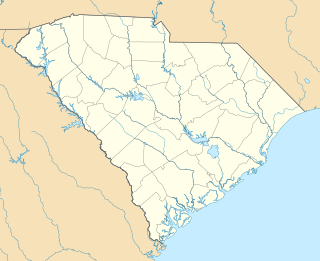
Padgett-Thomas Barracks is the dominant building on the campus of The Citadel in Charleston, South Carolina. Constructed from 1920 to 1922 as the first building on The Citadel's new site but demolished and replaced from 2000 to 2004, the barracks serves as the living quarters for up to 560 members of the South Carolina Corps of Cadets. The eight story tower which distinguishes it from the other four, smaller, barracks on Campus of The Citadel is also styled as a brand mark of the military college.
The Daniel Library is the main library of The Citadel, and is located on the college's Charleston, South Carolina campus. The library holds approximately 180,000 volumes in addition to extensive digital collections.





















